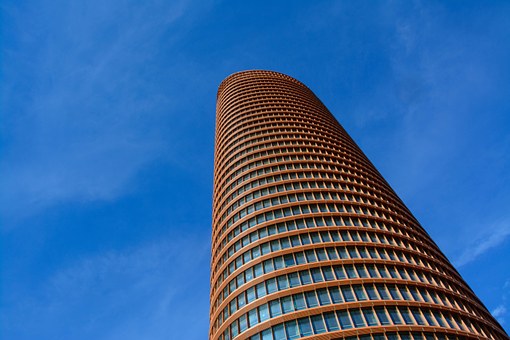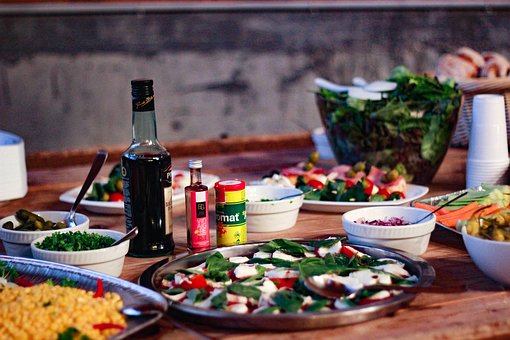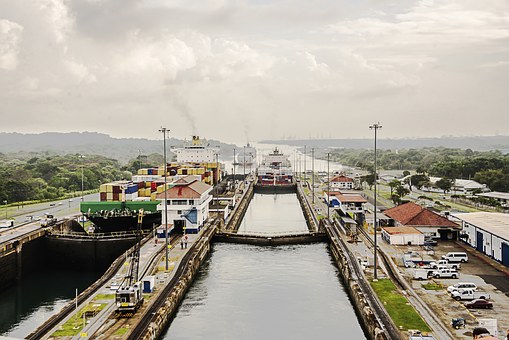Written by: Tina (Hyunsu) Ryu
About the Author: Tina is a senior majoring in computer science games. Before moving to California, she lived in Ohio and South Korea. After graduation, she hopes to go abroad to become a digital nomad!
Abstract
The conventional agricultural system fails to keep up with the expanding population as it not only wastes water but also relies heavily on fair weather conditions and the type and amount of available land. Due to these problems in conventional farming, more and more countries have adopted vertical farming. This concept involves cultivating crops on vertically stacked layers in high-rise buildings with carefully controlled climates. Could these futuristic greenhouses revolutionize our agriculture industry?
Too Many People, Too Little Food
According to the United Nations, the world’s population has been growing exponentially “ by about one billion every 13 years” [1]. To feed this growing population, the world would need to increase the number of harvests by at least 30 percent each year [1].
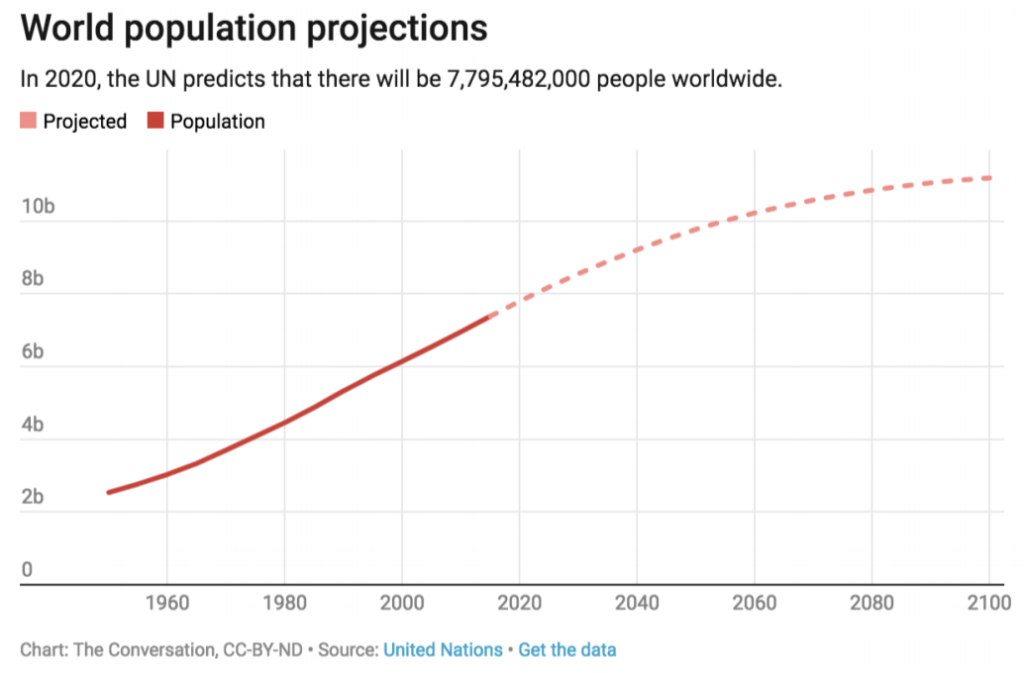
However, the current traditional farming methods are unreliable; they depend heavily on external factors like arable land and fair weather conditions, making the production of crops unpredictable in terms of both quality and quantity. In addition, the crops are grown outdoors, where they remain vulnerable to natural disasters and pests. A minor offset like a shift in temperature or a spread of harmful insects could damage an entire year’s worth of harvest. This volatility leads to more than 40% of the crops being wasted each season [2]. Increasing the production of food and reducing waste is crucial in keeping everyone fed and healthy with growing populations. In fact, according to Ernst Van den Ende, managing director of Wageningen University & Research’s Plant Sciences Group in the Netherlands, by 2050, we will have more than 10 billion mouths to feed, compared to 7.5 billion today [3]. To keep up, farmers must yield more crops in the next decades than our ancestors had to in the last thousands of years.
Moreover, humanity is in a cyclic predicament: as the population rises, the need for crops and their respective lands also rises; meanwhile, the amount of available arable land is only declining.
The lands that meet healthy agricultural standards are already farmed or rationed to be urbanized [4]. By 2050, the amount of amicable soil left on land will decrease by one third due to widespread drylands, natural disasters, and water supply reduction caused by climate change and urbanization [4]. As this trend continues, farms will not be able to follow the population in its expansion, causing food to run low and prices to skyrocket.
Expanding Vertically in Controlled Environments
However, what if farms were built upwards in controlled, insulated environments? Vertical farming is based indoors in a high-rise multilevel structure, free from pests and natural disasters. The greenhouses produce large quantities of clean food and reduce the use of fossil fuels, transportation, and water [4]. Vertical farming makes use of automatic temperature, humidity controls, and solar panels to heat and light the building. With these methods, the environmental conditions are constantly controlled, enabling year-round harvests.
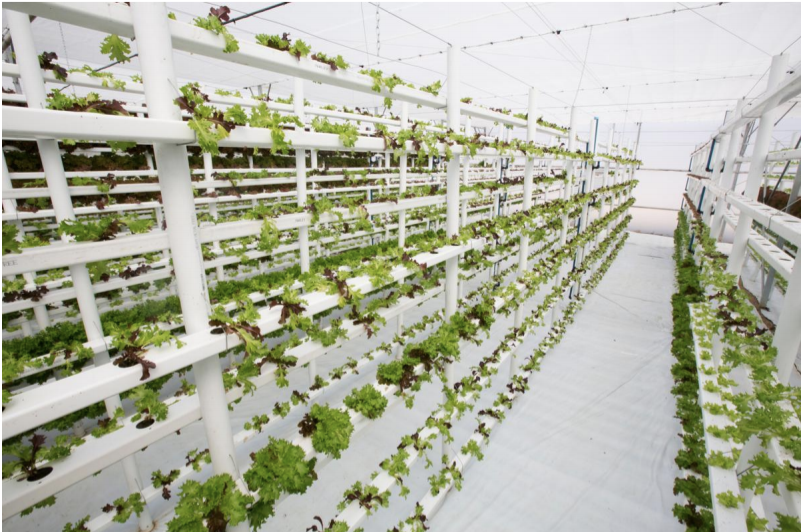
The Design of Vertically Inclined Farms and Their Harvests
Vertical farms, also known as sustainable greenhouses, are typically located in urban areas to take advantage of their compact characteristics. In order to provide enough food for 15,000 people, the typical vertical farm model is around 167.5 meters high and 44 meters long, making the building very narrow with a total space of only 28 meters squared (around the size of city block) [5]. In these buildings, engineers are able to build vertical stacks of arable land artificially in multiple floors, eliminating the need for arable land outdoors.
Inside, the building has separate floors dedicated to agriculture, aquaculture, environmental regulations, waste management, germination and sowing, and packaging crops [5]. Every bit of the building’s layout is intentional; the agriculture is placed at the top to absorb the solar energy to produce oxygen for insect ecosystems, with the aquaculture right below. The waste management and food processing floors are located near the ground to keep in-and-out transportation efficient. Furthermore, with all of the resources and produce enclosed in one area, recycling the inputs and outputs of food systems becomes incredibly easy–just the mist from the air could be gathered and recycled for their excess nutrients.
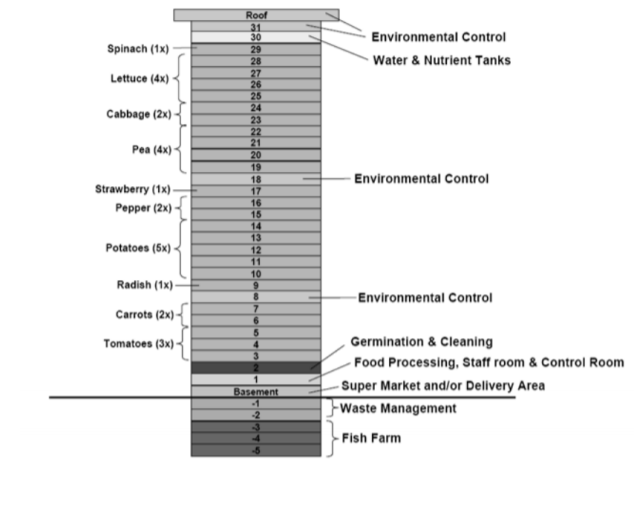
The heavily controlled and insulated environment protects against floods, droughts, and pests. A model with the above dimensions will increase land productivity by double and produce 3,573 tons of food in a year, which is 516 fold more than traditional farming [5]. As the population and urbanization rise, wasting even a few crops in a harvest could be detrimental; to decrease waste, more and more countries are transitioning into vertical farming.
Today’s Leaders in Vertical Farming
Singapore
According to Permaculture Research Institute, Singapore has an area of 710 square km with a population of 5 million and is“one of the most densely populated cities in the world” [6]. Since 2014, Singapore’s government has invested in vertical farming and used the country’s remaining 250 acres to expand vertically; before then, nearly 90 percent of food in Singapore’s groceries were imported. The percentage of imported food decrease by 10 percent in the first year of vertical farming and continues to follow this trend, helping the country become independent from foreign traders [6].
This vertical farming system is spearheaded by Jack Ng, engineer, entrepreneur, and farmer, who helped develop the “AGroGro” technology, a six-meter-tall, A-shaped tower that consists of 22 to 26 tiers of growing troughs [6]. This tower system, run by a water pulley system that uses one liter of rain water, rotates the troughs at one meter per second to ensure that all crops get proper sunlight and airflow.
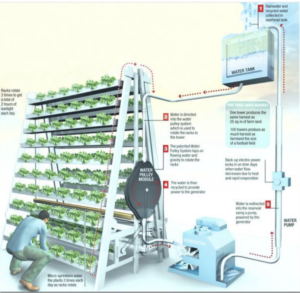
The Netherlands
Similar to Singapore, the Netherlands is a very small and densely populated country with “ more than 1,300 inhabitants per square mile,” yet they are the second largest exporter of food (behind the United States) in the world [3]. Their success could be due to their transition into vertical farms; as the leaders of sustainable farming, the Dutch produce most of their foods in “climate-controlled greenhouses” with “24-hour LED lighting” [3]. Since 2004, the Netherlands has expanded vertical farms throughout the country, producing and exporting fresh foods all year round.
Moreover,the rainwater collector on roofs of these greenhouses promotes energy efficiency. According to Van den Ende and other researchers, “ each kilogram of tomatoes from fiber-rooted plants requires less than four gallons of water [with vertical farms], compared with 16 gallons for plants in open fields” [3]. This is a notable decrease in water usage for crops.
No More Waste
Most vertical farming designs use rainwater or water from other plants, reducing waste. The agriculture industry accounts for 90 percent of global water consumption, and with the trend only increasing, more than half of the world population will experience water scarcity by 2030[7]. To counter this, vertical farmers have developed a way to recycle water; the greenhouse environment is controlled with precise inputs (resources that are fed into systems like tomato or potato production) and outputs (resources that result from those systems).
With this precision, farmers can reuse water from one system to another. For example, the wastewater produced by potatoes is automatically drained and saved before the “nutrient extraction process,” where the potatoes are purified with volcanic rocks and water; the water is then drained into another system [4]. With these methods, farmers can be more intentional with water usage and decrease consumption significantly.
In another example, the Netherlands has transitioned most traditional farms to the vertical farms and reported the positive results in water conservation efforts [3]. Van den Ende and his insulated greenhouses in the Netherlands report that key crops, such as tomatoes, spinach, and potatoes, have reduced water dependence by nearly 90 percent [3].
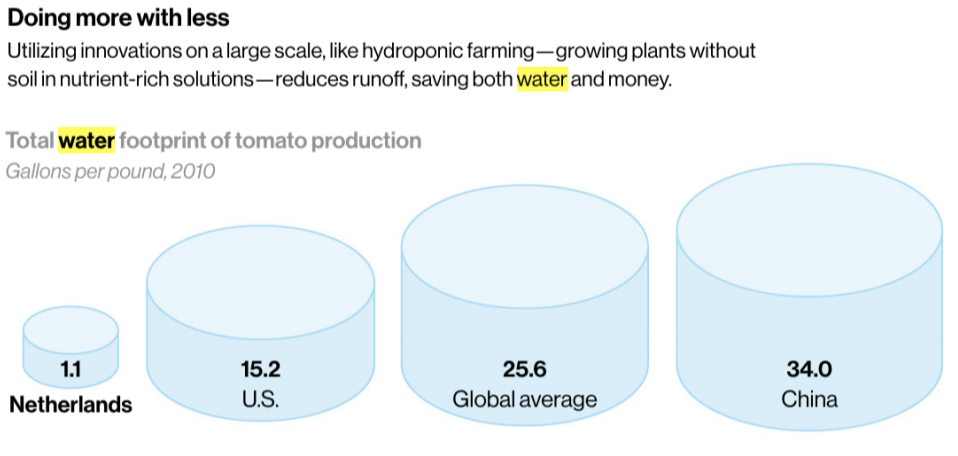
Vertical farming not only reuses water during its food production but also converts wastes such as inedible parts of crops and feces into inputs for other food systems. The Association of Vertical Farming reported the inputs and outputs of the vertical farming process, and more than 70 percent of inputs of one system comprised of outputs from other various systems [8]. For example, one of the food systems is the basil system. When the basil is fully grown, it can be harvested; however, the root of the basil is an output of this process because it is inedible and would usually be wasted in traditional farming. In vertical farming practices, these roots are oxidized to create carbon dioxide for plant systems. In return for taking carbon dioxide, plants provide oxygen for fish, insects, and mushrooms [9]. Not only does this cycle allow the greenhouse to survive without outside air, but it also reduces need for carbon dioxide fertilization for plants. Fertilizers are also made with the waste of fish for other cultivation systems like mushrooms and potatoes; the fish are sources of ammonia that bacteria transforms into nitrate, an important resource for plants [7]. With the inputs and outputs overlapping among ecosystems, vertical farming supports a circular economy of resources, facilitating sustainability and financial responsibility.
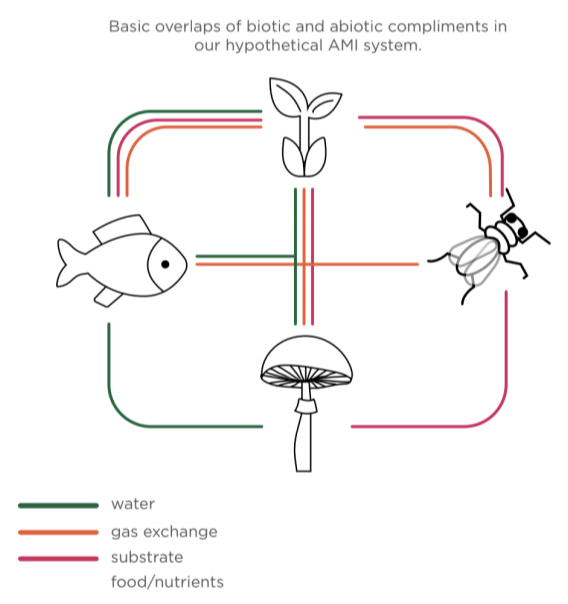
Making an Investment in the Future of Agriculture
Reusing resources in vertical farming is not only environmentally effective but is also economically advantageous. Although the initial costs of greenhouse-like skyscrapers can be high, the revenue from recycling resources and large, year-round food production could break even with startup costs within a few years [4]. For example, the vertical farm in Singapore run by Jack Ng spent about 10,000 US dollars for just the technology (automatic watering system, recycling system, etc); however, Ng states that his farms ship vegetables “to neighboring countries like Malaysia, Indonesia, and from far off countries such as China, US and countries from Europe.” [9]. From the exports, the farm has tripled its profits.
In addition, because vertical farming is carried out in a controlled and insulated environment, crops have a higher chance of being harvested successfully, decreasing the amount of waste and increasing production value. For example, the “AGroGro” technology used in Singapore saves a significant amount of money due to its efficiency (e.g. the system is run by technology that rotates crops for optimal sunlight and airflow) and recycling [9]. Moreover, less resources will need to be purchased with vertical farming. This sustainable methodology also does not require fertilizers, pesticides, or herbicides as the pest control and maintenance levels are automatically monitored [8].
Another economic advantage is that vertical farming could create more jobs. With the highrise greenhouses cultivating crops year-round, more hands will be needed, generating high levels of employment for farmers, scientists, marketing teams, maintenance people, and other agricultural and technological workers [7]. Providing stable careers to more people and spending less on resources is an economic victory in the long run.
Another Change in Our Dynamic World
Agricultural advancements are made throughout history to fit humanity’s needs and the environment; however, as the population grows, not only is the globe unable to feed all of its inhabitants, but it is running out of fertile land and other essential resources such as water and fuel. With countries like Singapore and the Netherlands slowly leading the way in the vertical farming industry, more and more countries could make the switch to sustainable farming. In comparison to conventional methods, vertical farming reduces water consumption, use of fossil fuels, and energy, and can be harvested year-round. In the coming decades, more countries may transition to vertical farming to reap its economic and environmental benefits to accommodate the growth of the world.
References
[1] Hwang, A. (2018). 7.5 billion and counting: How many humans can the Earth support?. [online]
The Conversation. Available at:http://theconversation.com/75billionandcountinghowmanyhumanscantheearthsupport98797 [Accessed 19 Nov. 2018].
[2] M. Esposito, T. Tse, K. Soufani, and L. Xiong, “Feeding the Future of Agriculture with Vertical Farming (SSIR),” Stanford Social Innovation Review: Informing and Inspiring Leaders of Social Change . [Online]. Available: https://ssir.org/articles/entry/feeding_the_future_of_agriculture_with_vertical_farming. [Accessed: 31Aug2018].
[3] J. Treat, National Geographic , 14Jan2018. [Online]. Available: https://www.nationalgeographic.com/magazine/2017/09/hollandagriculturesustainablefarming/. [Accessed: 05Sep2018].
[4] K. Benke and B. Tomkins, “Future foodproduction systems: vertical farming and controlledenvironment agriculture,” Taylor & Francis . [Online]. Available: https://www.tandfonline.com/doi/full/10.1080/15487733.2017.1394054. [Accessed: 31Aug2018].
[5] C. Banerjee and L. Adenaeuer, “Up, Up and Away! The Economics of Vertical Farming,” Journal of Agricultural Studies , vol. 2, no. 1, p. 40, Sep. 2014.
[6] Krishnamurthy, R. (2018). Vertical Farming: Singapore’s Solution to Feed the Local Urban Population. [online] The Permaculture Research Institute. Available at: https://permaculturenews.org/2014/07/25/verticalfarmingsingaporessolutionfeedlocalurbanpopulation/[Accessed 21 Nov. 2018].
[7] Un.org. (2018). Water scarcity | International Decade for Action ‘Water for Life’ 20052015 . [online] Available at: http://www.un.org/waterforlifedecade/scarcity.shtml [Accessed 9 Sep. 2018].
[8] A. Sarkar and M. Majumder, “Opportunities and Challenges in Sustainability of Vertical EcoFarming: A Review,” Journal of Advanced Agricultural Technologies , vol. 2, no. 2, 2015.
[9] V. Acker, “Vertical Farm 2.0: Designing an Economically Feasible Vertical Farm – A combined European Endeavor for Sustainable Urban Agriculture ,” Association of Vertical Farming . [Online]. Available: https://verticalfarming.net/whitepapers/. [Accessed: 05Sep2018]. [10] Z. Van Acker, “Controlled Agriculture and Ecosystem Economies,” Association for Vertical Farming .

